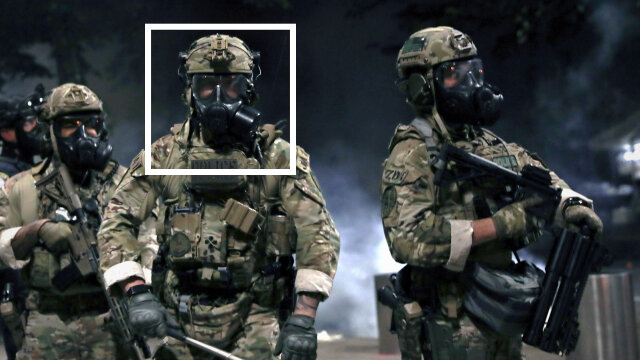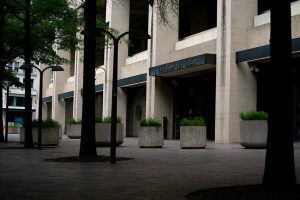When a video showing George Floyd’s death in police custody spread across social media, cities and towns nationwide soon erupted in protests against systemic racism and police brutality. But while protests in many places subsided after a few weeks, Portland, Ore., has been holding demonstrations every night since May 29.
The arrival of federal forces in the city this month — and concerns they were exceeding their authority and violating protesters’ rights — drew the ire of local officials and reinvigorated nightly demonstrations. With renewed force, marchers have spray-painted the walls of the U.S. District Court building, demanding that federal agents go home. Groups of mothers have banded together, locking arms and chanting: “Feds stay clear. Moms are here.”
Early in the protests, protesters broke into the Multnomah County Justice Center and set some of the offices on fire, and the Portland police have reported cases of looting. More recently, demonstrators have thrown rocks and bottles at federal officers. But many have protested peacefully, and Gov. Kate Brown has called the presence of federal agents an “abuse of power.”
President Trump has called the demonstrators “anarchists” who “hate” the country, and Chad F. Wolf, the acting secretary of homeland security, has blamed Oregon officials for the unrest.
Back
transcript
Videos Show How Federal Officers Escalated Violence in Portland
Peaceful protests were already happening for weeks when federal officers arrived on July 4. Our video shows how President Trump’s deployment ignited chaos.
-
Federal officers in military gear … … clouds of tear gas … … crowd control munitions … [shots fired] … and locals who want those officers gone. “What are you guys protecting?” “Get the [expletive] out of our city!” In just over a week, the chaotic scenes in Portland grabbed the nation’s attention and raised questions about whether the U.S. government is exceeding its authority and violating civil rights. The officers came because of an executive order signed by President Trump in late June to protect federal property from destruction. “If we didn’t take a stand in Portland, you know, we’ve arrested many of these leaders. If we didn’t take that stand, right now you would have a problem like — they were going to lose Portland.” So what’s going on here? And what methods are the officers using to protect federal sites? Crowd: “Breonna Taylor!” The protests against racism and police brutality, which started in May, had largely been peaceful and were held across Portland. But after federal officers arrived in the city on July 4, demonstrations became centered around this U.S. District courthouse and this building housing federal agencies. Both are property of the U.S. government. The buildings have clearly been vandalized, and the Department of Homeland Security has a mandate to protect them. That’s usually done by officers from the Federal Protective Service. But on the ground in Portland, we have seen a new task force, including U.S. Marshals … … BORTAC, a unit of Customs and Border Protection … … and a special response team from ICE, the Immigration and Customs Enforcement agency. According to a government memo leaked to The Times, these units are insufficiently trained to perform crowd control. But that hasn’t stopped them from trying. Night after night, videos show these officers emerging from the two federal buildings as protesters draw near. Hundreds of videos reviewed by The Times show that although protesters were antagonistic, officers often responded with disproportionate force. [shouting] They blanketed streets with tear gas. “Are you OK?” They struck protesters with batons … … and used flash bangs, pepper balls and other less-lethal munitions to clear the streets. [chanting] Their actions often appeared to escalate rather than de-escalate matters. And in some instances, they attacked when there was no apparent threat. On July 11, protester Donavan La Bella was at the federal courthouse when an officer appears to have fired at his head in retaliation for tossing a spent tear gas canister. “[expletive] you!” [shot fired] La Bella’s mother told local media he suffered skull fractures and needed surgery. Later that night when field medics sought officers’ help for a wounded protester, they were aggressively cleared away. On July 18, a Navy veteran was batoned and pepper-sprayed in another unprovoked attack. His right hand was broken, and he needs surgery. Sometimes members of the press were hit. “He got shot in the back, obviously, and he’s wearing press —” This photographer, Mathieu Lewis Rolland, told The Times that a volley of 10 projectiles were fired into his back. “Ow, ow, ow!” In the middle of all this, protesters were detained in ways that alarmed civil rights advocates and former Homeland Security officials. “Can your people identify themselves as law enforcement?” On July 15, several federal officers were filmed driving in unmarked vehicles in the blocks around the courthouse. “How are we supposed to know who you are? How are we supposed to know you’re not kidnapping us and you’re civilians kidnapping us?” One protester was detained at this location nearby. “What are you doing?” Federal officers wouldn’t identify themselves … “Use your words!” … but patches on the right and left sides of their uniforms match those used by members of BORTAC, the tactical unit from Customs and Border Protection. They drove the protester away in an unmarked car. D.H.S. says federal officers have made 43 arrests since July 4. Agents do have the authority to make arrests if they believe that a federal crime has been committed, like damaging federal property or attacking officers. Crowd: “Hey, hey, ho, ho, these racist cops have got to go.” In recent days, the controversy mobilized a larger and more diverse crowd of protesters. [chanting] A so-called wall of moms led marches through Portland’s streets and to the federal courthouse where officers cleared them away. The federal presence has also inflamed tensions. Some demonstrators damaged paneling on the courthouse and tried to set them alight. Others threw water bottles and fired fireworks toward the building. On Wednesday, July 22, Portland’s mayor joined the protests and was caught in a cloud of tear gas. “This is a egregious overreaction on the part of the federal officers. This is not a de-escalation strategy. This is flat-out urban warfare.” At around the same time, a Customs and Border Protection plane was spotted circling overhead. C.B.P. officials told The Times it was sending a live video feed of the crowd to law enforcement on the ground. Crowd: “No justice, no peace! Protesters and local officials say this is all a case of federal overreach. Oregon’s attorney general has sued the federal government to stop arresting people. “Gas! Gas! Gas!” The president has doubled down, promising to send more federal officers to cities governed by his political rivals. “Because we’re not going to let New York and Chicago and Philadelphia, Detroit and Baltimore, and all of these — Oakland is a mess — we’re not going to let this happen in our country. All run by liberal Democrats.” The results could look like a national police force acting under presidential orders, able to ignore local demands and arrest residents. In Portland, it has been a recipe for chaos. [explosion]
What are the protesters demanding?
What started out as a movement for police accountability and racial justice has morphed into a complex mobilization. The protesters’ goals now include defunding the police, addressing income inequality and pushing federal agents out of the city.
In Portland, which is one of America’s whitest cities and has a racist history, protesters have maintained a public call for change that has subsided elsewhere in the country.
Experts say the protests bring together a coalition of racial justice proponents and anti-fascist advocates, who have long been active in Portland. The groups share some intersecting grievances and common goals, such as cutting police budgets and installing more civilian oversight of the police.
Signs such as “White Silence=Violence” and “Black Lives Matter” are widespread, and calls at the demonstrations to address racial inequities persist. One woman held a sign that said: “My Black Child is Watching! #BLM She Will Know Her Life Matters.”
Demonstrators have also expressed increasing frustration with the federal presence and the Trump administration.
“What is making more people come to the street every night now is the brutalization that’s happening to regular community members at the hands of Portland police and these federal agents,” Jo Ann Hardesty, a city commissioner, said at a news conference.
How has the city responded?
Street protests began four days after the death of Mr. Floyd in Minneapolis. As the demonstrations continued and officers used tear gas to disperse crowds, public outrage against aggressive police tactics increased and calls to defund the police escalated.
On June 8, after more than a week of large-scale demonstrations involving thousands of marchers, the chief of the Portland Police Bureau stepped down, saying new leadership was needed to rebuild public trust. Shortly after, a federal judge upheld restrictions on tear gas put in place by Mayor Ted Wheeler, barring the use of the chemical agent except when life or safety was at risk.
The City Council also passed a budget that would cut $15 million from the police in the upcoming fiscal year, a demand sought by protesters.

Why have the protests continued this long?
By late June, the size of protests had diminished significantly. Rose City Justice, a major mobilizing force in Portland, announced plans to pull back on organizing efforts. Nightly marches, numbering in the hundreds, became more decentralized.
But after federal agents, including some from the Department of Homeland Security, arrived in July, reports soon emerged that they had forcefully pulled people into unmarked vehicles, injured protesters, and deployed tear gas. Mayor Wheeler, who called the situation “an attack on our democracy.” was tear-gassed with a group of protesters outside the federal courthouse.
By the time the federal agents arrived, city leaders said, the situation on the streets had de-escalated. But outrage at the Trump administration’s deployment reinvigorated the daily rallies.
Which federal law enforcement agencies are involved?
The federal agents present in Portland include personnel from the U.S. Marshals and tactical agents from Customs and Border Protection and Immigration and Customs Enforcement, in addition to the Federal Protective Service, which was already stationed to protect federal property in Portland.
Some of the agents are from a group known as BORTAC, the Border Patrol’s equivalent of a SWAT team, which typically investigates drug smuggling organizations.
What is motivating the movement in Portland?
Oregon has a history of white supremacy. A law passed in 1844 said that any Black person would be “whipped twice a year until he or she shall quit the territory” and leaders also later banned Black people from entering the territory.
Some protesters say the state’s deeply racist history is still reflected in Portland’s structures. One protester, Reginald Liggins, who is Black, told The New York Times that he began commuting by bus after being pulled over multiple times by the Portland police without reason. Liza Lopetrone, a veterinary nurse who is white and joined the Wall of Moms protest this week, said she wanted to bring the state’s white supremacist legacy to light.
Others were not moved to participate until federal agents entered the city. Christopher J. David, a Navy veteran who was filmed being beaten with a baton by federal officers, had not followed the protests until U.S. agents were deployed. He came to the protests to ask officers about their use of violent tactics against protesters, which he said conflicted with their oath to uphold the Constitution.
Reporting was contributed by Mike Baker, Thomas Fuller, John Ismay, Zolan Kanno-Youngs and Sergio Olmos



















